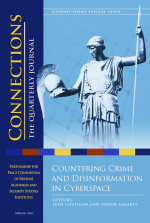Today, cyberspace is deeply challenged by a variety of largely political concerns. This new humanizing of cyberspace may seem fitting to some who fretted for years over a relative lack of high-level political interest in the world’s only new “domain.” With cyber now being the topic of the day, it is easy to forget that, however notional, cyber was considered too technical to be worthy of elite policy attention until suddenly it was red hot and everywhere. Yet, as cyber silently built momentum and impacts loomed, people in the know understood that cyber was more than a technical issue and began building programs of study and fashioning a new realm of knowledge that was combinatorial and interdisciplinary by nature. Just as there could be no cyber without technology, there was no way to do cyber without people.
This issue of Connections is a case in point. It brings to the readers’ attention eight original articles presenting novel challenges that go beyond state-sponsored cyber operations [1] and look into cybercrime, corruption, dissemination of hate speech, propaganda, and disinformation in cyberspace, as well solutions from the realms of technology, policy-making, legislation, education and training.
Whether it is a consideration of how trust is developed between private companies [2] and people in cyberspace or the emerging developments and likely impacts of quantum computing,[3] we are entering a unique time for the study of cybersecurity. Technology will continue its march, in many cases driving new challenges to the surface, but mature policy and scholarship, such as what we see in this issue, will help situate change and create resilience. Technology and policy are joined at the hip. Cybersecurity is no longer a necessarily but largely insufficient technical pursuit designed to make products safer. It is a wholly mature field with dozens of interrelated, equally critical fields of inquiry.
As challenges mount, people and their awareness and skills become ever more critical.[4] Each advancing year the global population becomes increasingly dependent on cyberspace and a measure of cybersecurity. Some political systems have become ever more fearful of the power of cyberspace, betting on more complex systems and networks to control their citizens’ perceptions [5] and shape their behavior and political destiny. Decoupling from the Internet has become a goal for too many states.[6] Disinformation campaigns move across borders and target individuals with precision, putting individual resiliency and critical thinking to the test.[7] Research in this issue shows just how important cyber skills are for the functioning of society.
Democratized tools and knowledge mean that cybercriminals can now have the same power as states or large corporations. What were once small-time operations are very often now criminal cartels, some even running crime as a service, while police and authorities come to grips with the new face of cybercrime.[8] States are also using the new threat of cybercrime to justify radically different visions of cyberspace.
In the meantime, global workforce challenges hamper our collective ability to secure cyberspace and improve the infrastructure on which we rely.[9] To meet the need, cybersecurity programs must do their utmost to graduate experts with knowledge of all facets of cyber: people, process, and technology.
This issue of Connections is dedicated to all the hard-working cybersecurity experts out there. We are grateful for your dedication and sense of mission.
Finally, a great measure of thanks goes to the authors of this issue and their patience as this excellent issue finally comes together.
Disclaimer
The views expressed are solely those of the authors and do not represent official views of the PfP Consortium of Defense Academies and Security Studies Institutes, participating organizations, or the Consortium’s editors.
Acknowledgment
Connections: The Quarterly Journal, Vol. 20, 2021, is supported by the United States government.
About the Authors
Sean S. Costigan is a Professor at George C. Marshall European Center for Security Studies and Senior Advisor to the Emerging Security Challenges working group of the Partnership for Peace Consortium.
E-mail: sean.costigan@marshallcenter.org
Todor Tagarev is an experienced security and defense policymaker with a background in cybernetics and control theory and applications. He is currently a professor at the Institute of Information and Communication Technologies of the Bulgarian Academy of Sciences and leads its Centre for Security and Defence Management. Prof. Tagarev has been a member of the Editorial Board of Connections: The Quarterly Journal since 2004. https://orcid.org/0000-0003-4424-0201

